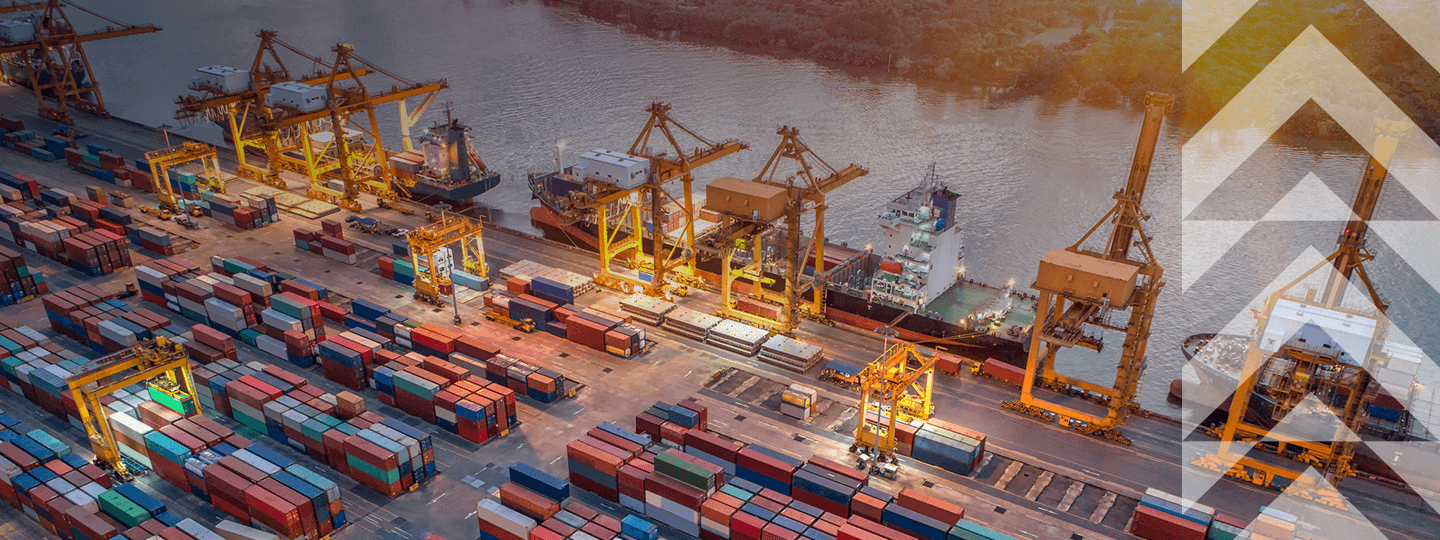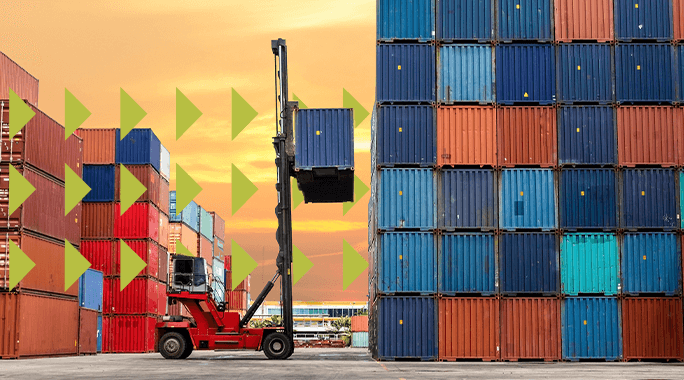BLOG POST
Intermodal vs. multimodal freight: Which is right for you?

Reading Time: 5 minutes
When it comes to freight shipping, there's no one-size-fits-all solution. Depending on the nature of your cargo, its size, weight, urgency and distance, choosing the right freight shipping method can significantly impact your bottom line. While many people think of freight being shipped by truck, there are other modes of transportation available — air, sea and rail.
In fact, you may find that combining multiple modes of transportation is more effective, especially when shipping goods over long distances. Imagine shipping freight from Texas to Michigan, where a train can carry your shipment across much of the land, a boat can cross Lake Michigan, and a truck gets your cargo to and from the docks. Or consider shipping a large load from Minnesota to Germany — trucking it to a rail terminal, then moving it by train to a port, and finally transferring it onto a cargo ship.
This is where intermodal and multimodal transportation come into play. Both involve using more than one mode of transport, but they differ in many ways. Understanding these differences will help you make an informed decision about which method is best for your freight shipping needs. And we are here to help you!
What is intermodal shipping?
Intermodal freight shipping refers to moving cargo using more than one mode of transport, typically rail, truck or ship, but with a major distinction. In intermodal transportation, you, the shipper, are responsible for choosing a different carrier for each leg of the journey. This means you'll create multiple bills of lading, track the shipments with each carrier and handle individual payments.
This method gives you more control over your shipment. For example, you can negotiate pricing with different carriers and choose the most cost-effective routes for each segment. However, it also requires more hands-on management. You'll need to stay on top of all the logistics and coordinate between multiple parties, which can be time-consuming.
A key feature of intermodal shipping is that freight is usually transported in a single container that can be transferred between various modes of transportation (like rail, truck or ship). This method minimizes the need to handle the cargo itself during the transitions, reducing the risk of damage, theft or delays.
What is multimodal shipping?
Multimodal shipping also combines different carriers and modes of transport, but there is one major difference — it's managed by a single logistics provider. Instead of handling multiple carriers, you'll work with one provider who will coordinate the entire journey, including scheduling, tracking and payment.
With multimodal transportation, you receive one bill of lading for the entire shipment, which simplifies the process. There's a single point of contact for all inquiries, and your provider manages the entire process from start to finish. This reduces your workload but limits your ability to negotiate on individual legs of the trip. You're often locked into a set price for the entire journey, with fewer opportunities to cut costs by selecting cheaper carriers or transport methods.
Unlike intermodal shipping, multimodal may not always use containers throughout the entire journey. The goods could be unloaded and repacked between different modes, which increases handling but also offers more flexibility for moving goods that don't fit in standard containers.
Intermodal vs multimodal: Key differences
Here's a quick comparison to help you understand the main differences between intermodal and multimodal shipping:
| Feature | Intermodal | Multimodal |
| Simplicity | Multiple bills of lading and invoices | One bill of lading, one point of contact |
| Control | Greater control over carriers, timing and routes | Less control over carriers and schedules |
| Time Efficiency | More time-consuming due to managing multiple carriers | Streamlined process with a single provider |
| Cost | Potential for cost savings with more flexibility and negotiations | Fewer opportunities to negotiate pricing |
| Environmental Efficiency | Ability to choose eco-friendly modes like rail | Less control over choosing environmentally sustainable modes |
| Handling | Less handling, as goods often remain in the same container | More handling, as goods may be repacked between modes |
| Nonstandard Goods | Less flexibility with oversized or specialized goods | More flexible for oversized or specialized cargo |
When To Choose Intermodal vs. Multimodal
Ultimately, your decision to choose intermodal or multimodal shipping will depend on the specific needs of your shipment. Let's take a look at some scenarios where one option may be preferable to the other.
Scenario 1: Cost-effectiveness
If your goal is to minimize transportation costs, intermodal shipping could be the way to go. It can be more cost-effective, especially when shipping large volumes over long distances. The ability to choose cheaper carriers and routes allows for greater savings.
Scenario 2: Sustainability goals
For companies aiming to reduce their carbon footprint, intermodal shipping is often a better choice. Rail transport, which is commonly used in intermodal shipments, tends to be more environmentally friendly compared to full truckload or airfreight options.
Scenario 3: Protecting your cargo
If cargo protection is a priority, intermodal shipping offers a distinct advantage. Since the goods are typically moved in the same container across all modes of transport, there's less handling of the freight. This minimizes the risk of damage, theft or delays.
Scenario 4: Shipping oversized or specialized goods
If you're shipping goods that don't fit in standard containers or require special handling, multimodal shipping offers more flexibility. Since multimodal doesn't always use containers throughout the journey, it can accommodate a wider range of cargo.
Scenario 5: Simplified management of multiple modes
If you have no choice but to use multiple transportation modes due to your shipment's route or nature, multimodal shipping may be the better choice. It simplifies the management of your freight, as there's only one point of contact and a single contract to manage.
Scenario 6: International shipping
For international shipments, intermodal shipping provides the opportunity to create a cost-effective shipping solution by combining different modes of transport. Rail and ocean freight can help reduce costs compared to airfreight.
If you're looking for a simpler, more straightforward international shipping process, multimodal shipping can offer a middle ground. You'll still save on costs compared to airfreight but without the complexity of managing multiple carriers.
Let Third-Party Logistics Experts Handle Your Freight Coordination
The logistics of intermodal and multimodal freight shipping can be overwhelming. Managing multiple carriers, modes of transport and paperwork can take valuable time away from running your business. That's where third-party logistics providers (3PLs) like Worldwide Express come in.
We are a top 10 freight brokerage company and a leading 3PL provider, helping businesses streamline their freight shipping by connecting them with the right carriers and managing the entire process for them. Whether you choose intermodal logistics or multimodal logistics, we're here to help you navigate the best shipping options for your needs.
Worldwide Express Can Help You Navigate Intermodal and Multimodal Freight
Worldwide Express has more than 30 years of success in the logistics industry and helps thousands of freight shippers of all sizes move products with great efficiency. We are also part of WWEX Group, alongside GlobalTranz and Unishippers.
Combined, these three companies make up one of the largest and most diverse 3PLs in the industry, providing shippers with top solutions that help them succeed. That includes teaming up shippers with top freight solutions and carriers from our network of 75+ LTL freight and 45,000+ FTL shipping carriers!
Ready to talk? Reach out for a free shipping consultation today!






